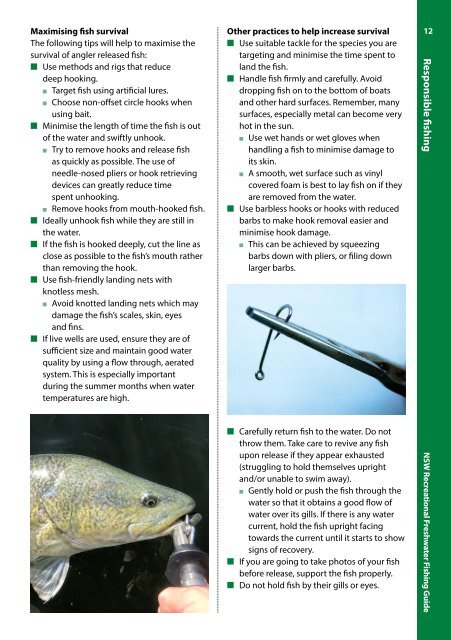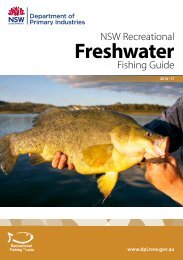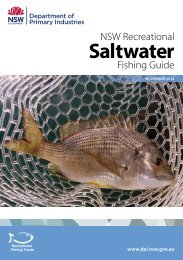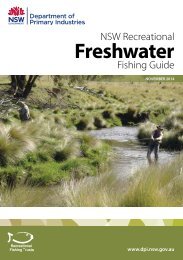freshwater-recreational-fishing-guide-2018-19
Create successful ePaper yourself
Turn your PDF publications into a flip-book with our unique Google optimized e-Paper software.
Maximising fish survival<br />
The following tips will help to maximise the<br />
survival of angler released fish:<br />
■■<br />
Use methods and rigs that reduce<br />
deep hooking.<br />
■■<br />
Target fish using artificial lures.<br />
■■<br />
Choose non-offset circle hooks when<br />
using bait.<br />
■■<br />
Minimise the length of time the fish is out<br />
of the water and swiftly unhook.<br />
■■<br />
Try to remove hooks and release fish<br />
as quickly as possible. The use of<br />
needle-nosed pliers or hook retrieving<br />
devices can greatly reduce time<br />
spent unhooking.<br />
■■<br />
Remove hooks from mouth-hooked fish.<br />
■■<br />
Ideally unhook fish while they are still in<br />
the water.<br />
■■<br />
If the fish is hooked deeply, cut the line as<br />
close as possible to the fish’s mouth rather<br />
than removing the hook.<br />
■■<br />
Use fish-friendly landing nets with<br />
knotless mesh.<br />
■■<br />
Avoid knotted landing nets which may<br />
damage the fish’s scales, skin, eyes<br />
and fins.<br />
■■<br />
If live wells are used, ensure they are of<br />
sufficient size and maintain good water<br />
quality by using a flow through, aerated<br />
system. This is especially important<br />
during the summer months when water<br />
temperatures are high.<br />
Other practices to help increase survival<br />
■■<br />
Use suitable tackle for the species you are<br />
targeting and minimise the time spent to<br />
land the fish.<br />
■■<br />
Handle fish firmly and carefully. Avoid<br />
dropping fish on to the bottom of boats<br />
and other hard surfaces. Remember, many<br />
surfaces, especially metal can become very<br />
hot in the sun.<br />
■■<br />
Use wet hands or wet gloves when<br />
handling a fish to minimise damage to<br />
its skin.<br />
■■<br />
A smooth, wet surface such as vinyl<br />
covered foam is best to lay fish on if they<br />
are removed from the water.<br />
■■<br />
Use barbless hooks or hooks with reduced<br />
barbs to make hook removal easier and<br />
minimise hook damage.<br />
■■<br />
This can be achieved by squeezing<br />
barbs down with pliers, or filing down<br />
larger barbs.<br />
12<br />
Responsible <strong>fishing</strong><br />
■■<br />
Carefully return fish to the water. Do not<br />
throw them. Take care to revive any fish<br />
upon release if they appear exhausted<br />
(struggling to hold themselves upright<br />
and/or unable to swim away).<br />
■■<br />
Gently hold or push the fish through the<br />
water so that it obtains a good flow of<br />
water over its gills. If there is any water<br />
current, hold the fish upright facing<br />
towards the current until it starts to show<br />
signs of recovery.<br />
■■<br />
If you are going to take photos of your fish<br />
before release, support the fish properly.<br />
■■<br />
Do not hold fish by their gills or eyes.<br />
NSW Recreational Freshwater Fishing Guide








